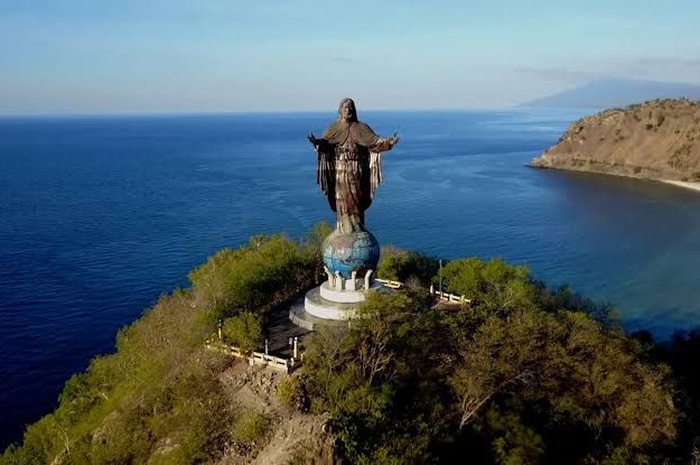While “Kristore” isn’t a widely recognized natural landmark or region in Timor-Leste, it’s highly likely you’re referring to Cristo Rei of Dili.
Here’s an article about Cristo Rei, a significant landmark in Timor-Leste:
Cristo Rei of Dili: Timor-Leste’s Iconic Symbol and Panoramic Vista
Perched atop Cape Fatucama, overlooking the capital city of Dili and the sparkling Banda Sea, stands the majestic Cristo Rei of Dili (Christ the King of Dili). This towering 27-meter high statue of Jesus Christ, standing atop a globe, has become one of Timor-Leste’s most iconic landmarks, a testament to the country’s strong Catholic faith and a beacon welcoming visitors to its shores. More than just a religious monument, Cristo Rei offers breathtaking panoramic views and holds a unique place in the nation’s history.
A Gift with a Complex Past:
The Cristo Rei statue was unveiled in 1996 as a gift from the Indonesian government to the people of East Timor, during the period when Timor-Leste was an Indonesian province. Designed and overseen by Mochamad Syailillah, an Indonesian artist, its construction aimed to commemorate the 20th anniversary of Indonesia’s integration of East Timor. While intended as a gesture of goodwill, the statue’s inauguration occurred during a time of significant political tension and the lead-up to Timor-Leste’s eventual independence.
Interestingly, the statue was built in Bandung, Indonesia, with the face of Jesus reportedly modeled with a simple, almost Greco-Roman style after consultations with church leaders in Jakarta. The 27 separate copper sections that form the body were shipped to Dili and assembled on the peak of Cape Fatucama, a process that took approximately three months. The monument’s total height, including the globe and a 10-meter high cross, reaches 34 meters.
A Symbol of Faith and National Identity:
Despite its complex origins, Cristo Rei has evolved into a significant symbol of Timor-Leste. For the predominantly Catholic population, it represents their deep-rooted faith and serves as a place of pilgrimage and prayer. The 14 Stations of the Cross that line the steep 570-step concrete staircase leading up to the statue’s base are a testament to this devotion.
Beyond its religious significance, Cristo Rei has also become a source of national pride. It stands as a prominent feature of Dili’s skyline, a welcoming figure for those arriving by sea and a reminder of the country’s unique journey. Its image is frequently used in tourism promotions and has become synonymous with the capital city.
Breathtaking Panoramic Views:
The journey to the base of Cristo Rei is well worth the effort, not just for the spiritual experience but also for the spectacular views it offers. From the platform beneath the statue, visitors are treated to sweeping vistas of Dili’s coastline, the bustling harbor, and the surrounding hills. To the north, on a clear day, the outline of Atauro Island can be seen on the horizon. Looking east, the beautiful “Jesus Backside Beach” (Pantai Belakang Yesus) stretches along the Wetar Strait. The perspective from Cristo Rei provides a stunning appreciation for the natural beauty of Timor-Leste’s capital.
A Landmark for Locals and Tourists:
Today, Cristo Rei is a popular destination for both locals and tourists. Families and individuals make the climb for exercise, reflection, and to enjoy the scenery. Tourists are drawn to its iconic status, its historical significance, and the unparalleled views. The area around the base of the statue is often bustling with visitors, particularly during weekends and religious holidays.
Preserving a National Treasure:
As Timor-Leste continues to develop its tourism sector, maintaining and preserving Cristo Rei remains important. It stands not only as a religious monument and a viewpoint but also as a tangible link to the nation’s past and a symbol of its present identity. Efforts to ensure the accessibility and upkeep of this iconic landmark will allow it to continue inspiring and welcoming visitors for generations to come.
In conclusion, while “Kristore” might not be the precise term, the Cristo Rei of Dili is undoubtedly a significant and recognizable landmark in Timor-Leste. Its towering presence, coupled with its historical context and breathtaking views, makes it a must-visit destination and a powerful symbol for the nation.



